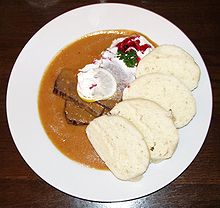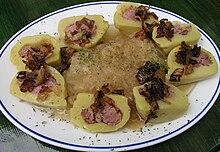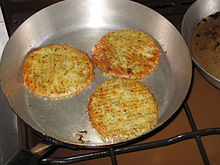Bohemian cuisine
The Czech cuisine ( Czech česká kuchyně ) is generally understood to be the traditional cuisine in the territory of the Czech Republic and also includes the kitchens of the Moravia and Silesia regions . It is primarily related to the Austrian and Hungarian , but also to the Bavarian , Saxon and Silesian cuisine . In the fertile Bohemian Basin , enclosed by a low mountain range , the range of crops, fruit, vegetables, berries , mushrooms , fish and game has always been diverse. Agriculture provided sufficient grain and meat, mainly pork and beef. The menu of the Bohemian cuisine developed accordingly. According to legend, the forefather Čech is said to have said about Bohemia that it was a land where milk and honey flowed.
General
Meat dishes dominate the main courses, especially pork. Lamb and fish are less common. They are characterized by the heavy use of salt and garlic . Other important spices are caraway , lovage , allspice and marjoram . Mostly Bohemian dumplings are served with meat dishes with sauces , with dishes with gravy potatoes or mashed potatoes . In the area of pasta only are traditional noodles ( nudle ) with egg usual, which will also cut with fondness square and then Fleckerl ( Fleky ) hot.
As in hardly any other national cuisine, vegetables are used sparingly in Bohemia. Many of the typical dishes are usually eaten without a vegetable side. Sauerkraut or freshly cooked white or red cabbage can often be found as a vegetable-like side dish .
Salads as a side dish are usually plain, often only served with vinegar water, often sweetened. Tomato salad is garnished with diced onions. Potato salad is an essential part of Bohemian cuisine and comes in two versions: as a full version with mayonnaise , (meat) sausage, boiled eggs, pickles, carrots, peas and onions, or as a simple side dish with just onions and with vinegar and oil . Diced bacon or apples may be added. The regional differences are considerable.
Sweets are varied, the “Bohemian pastries ” had a great influence on Austrian cuisine. Much used are poppy seeds and powidl (plum jam). In addition to the usual types of fruit, peaches and apricots , which are used in pastries , thrive on fruit , especially in warmer regions .
The Czech carp is famous and is also exported abroad. In the Czech Republic, Christmas carp is typically bought alive at the market and eaten with potato salad on Christmas Eve .
The Czech population of Bohemia and the German Bohemia did not differ in the style of cooking or the variety of recipes. As of 1945, the German-speaking population of Bohemia and Moravia marketed was, brought the refugees, many of which are in Bavaria settled, even the recipes of Czech cuisine with. They found their way into the already closely related Bavarian cuisine .
Soups
In the Czech vernacular there is a saying: " polívka je grunt, maso je špunt ", which freely means something like "soup the reason, meat the bung". This shows the importance of soup in Bohemian cuisine. Soups are usually brought to the guest in a cup and filled into soup plates at the table, with inserts also being added separately.
Choice of popular soups:
- Goulash soup ( Gulášová polévka ): Prepared like goulash , only more liquid and with a potato garnish , seasoned with paprika and caraway, corresponds to the Austrian goulash soup
- Semolina dumpling soup ( Polévka s krupičkovými knedličky ): the dumplings are harder and not as fluffy as usual in Austria
- Potato soup ( Bramborová ): the soup is thick and thickened with roux. A typical flavor-determining ingredient is lovage.
- Barley soup ( krupová polévka ): a variation of potato soup with soft-boiled barley . Often refined locally with mushrooms
- Garlic soup ( Česnečka ): mostly clear broth of boiled potatoes with caraway seeds, which is enriched with plenty of grated garlic. Roasted white bread cubes are arranged in the soup plate and only poured over with the broth at the guest
- Krkonošské kyselo , German: Giant Mountains sour soup, also known as Jizera sour soup: mushroom soup with a little cabbage and vinegar
- Tripe soup ( Dršťková polévka )
- Cabbage soup ( zelná polévka / zelňačka ): Cabbage soup, can be refined with other ingredients such as ham.
- Kulajda : Potato soup with a poached egg, mushrooms and sour cream.
Main courses
pork roast
The roast pork ( Vepřová pečené ) is the basis for the Czech national dish par excellence: Vepřo-knedlo-zelo ie "pork-dumpling-cabbage". The rather fatty meat with rind is rubbed with garlic. Side dishes are Bohemian dumplings and sauerkraut or freshly cooked cabbage with diced bacon and caraway seeds. Vepřo-knedlo-zelo is considered by the vast majority of the population to be the typical national food, even before the sirloin.
Sirloin
Svíčková ( svíčková na smetaně or sirloin on cream) is considered the special, specifically Bohemian dish. It is served with a creamy cream sauce that is enriched with strained vegetables and served with cranberries, lemon and Bohemian dumplings.
Bohemian dumplings
Of the many types of dumplings ( knedlíky ) common in the Czech Republic , the Bohemian bread dumplings (see Bohemian dumplings ) are the best known.
They are cooked in an elongated loaf shape and cut into slices, if by hand, then mainly with twine. The flour dough today is usually without yeast, but should contain lightly fried bread cubes.
Another specialty are potato dumplings, filled with small pieces of smoked meat, served with sauerkraut.
More typical dishes
-
Goulash ( guláš ) (Hungarian "Pörkölt")
- Szegediner goulash ( segedínský guláš , German: cabbage meat ) is originally a dish of Viennese cuisine.
- Liver goulash ( játrový guláš ): Often mixed types of liver or just poultry liver, seasoned with garlic and caraway seeds. Served with rice, pasta, potato dumplings or white bread.
- Sausage goulash ( buřtguláš ), also potato goulash ( bramborový guláš ): Goulash-like stew with pieces of sausage and potatoes instead of meat.
- Meatloaf ; Meatballs ( sekaná; karbanátky ): preparation like in Germany. Served with salad, mashed potatoes, etc.
- Breaded Christmas carp : Typical dish on Christmas Eve . Served with potato salad.
- Dill sauce ( koprovka; koprová omáčka ): A sauce made from flour (dry sweat), butter, milk and a little water, which is richly refined with chopped dill just before serving. Regional with offal (heart, lungs and liver).
- Risotto ( rizoto ): In the Bohemian kitchen, the finished risotto is also baked with cheese. The rice is often cooked separately.
- Letscho ( lečo )
- Sour porcini mushrooms : Served with Bohemian dumplings as a side dish.
- Prague ham ( pražská šunka ), a bohemian cooked ham that is traditionally served warm.
- Czech beef rolls ( Španělští ptáčci shortly ptáčci , literally: Spanish birds ) are smaller beef rolls filled with bacon, sausage, pickle and egg. Dumplings or rice are served as a side dish.
- Stuffed peppers in tomato sauce, the sauce ( rajská omáčka ) is made from butter and onion melted flour, allspice, cloves, whole peppercorns, bay leaves and tomato paste. Traditionally, the peppers are filled with minced meat and cooked in the sauce or baked separately in the oven. They are served with bohemian dumplings or rice.
- Ham steak ( šunkofleky ).
- Pasta with spinach and fried egg.
- Baked cheese ( smažený sýr ) is a dish that is often encountered in the Czech Republic, but it is not part of Old Bohemian cuisine - it owes its widespread use to the considerable price difference between meat and cheese during the planned economy . It is breaded cheese that is offered filled or unfilled. 100 to 150 grams of cheese are calculated per person. One uses 1 to 2 centimeter thick slices of hard cheese (preferably Edam cheese ) or whole Camembert loaves. Prague ham is sometimes used as a filling . Breaded cheese is served with tartare ( tatarka ) sauce. Boiled potatoes or French fries are served as a side dish .
- Puffer peas ( pučálka ): pre-germinated and puffed peas.
- Potato pancakes ( bramborák ): Traditionally a hearty dish that is not served with applesauce . Raw potatoes are either coarsely or finely grated and mixed with garlic, marjoram, salt, egg and flour. The size and thickness of the patties fried in a pan with lard or oil differ from region to region. Regionally refined with ham and cheese.
Desserts
- Plum dumplings ( švestkové knedlíky ) and apricot dumplings ( meruňkové knedlíky ): Dumplings made from flour, potato or curd dough , which you fill with plums or apricots and boil in salted water. When serving, they are sprinkled with grated curd cheese, poppy seeds and powdered sugar and drizzled with brown butter. There are also other types of fruit dumplings, for example with strawberries .
- Powidlknödel ( povidlové knedlíky ): similar to Austrian yeast dumplings , but smaller. One serving consists of several dumplings.
- Powidldatschgerl ( povidlové taštičky ): dumplings filled with powidl.
-
Buchteln ( buchty ): Pieces of dough with a powder or poppy seed filling, baked in a roaster to twelve or more pieces. Small Buchteln ( buchtičky ) are unfilled and eaten with vanilla sauce, comparable to steamed noodles .
- Powidl filling: Powidl as desired with lemon peel, cinnamon, rum and sugar as required and tied with grated gingerbread. As a filling for pastries.
- Poppy seed filling: Ground poppy seeds are boiled with milk and sugar for a quarter of an hour. Sugar, vanilla, almonds and cloves are stirred into the cooled mass; then the filling is tied with gingerbread or spoon bisquit crumbs. As a filling for pastries.
- Quark filling: mostly with lemon peel, vanilla, rum-raisins and sugar. Another typical pastry filling
- Kolatschen (general koláče , regional české koláče or moravské koláče ): Round pieces of dough made from yeast dough, in the middle with quark, powder, poppy seeds or pieces of fruit, individually baked on a tray. Not to be confused with the Austrian Kolatsche , which are also common in the Czech Republic.
- Dalken ( Vdolky ) are a pastry made from yeast dough and coated with powder or jam, as well as with stiff cream.
- Liwanzen ( lívance ) are similar to the Dalken, but usually have a larger diameter. You can either brush them with powder or jam or sprinkle them with a mixture of ground poppy seeds, sugar and cinnamon . They can also be decorated with sour cream .
- Pancakes ( palačinky ): Thin egg pancakes, although thicker and not as dry as French crepes , traditionally coated with apricot or sometimes other jam , rolled and sprinkled with powdered sugar. In restaurants geared towards tourists, they are often served (based on the Hungarian Gundel-palacsinta ) with grated nuts or almonds, sometimes with whipped cream and ice cream, and also covered with chocolate sauce.
- Profiteroles with caramel cream filling ( karamelové Větrníky ): Small curls of fire mass , usually filled with a caramel cream
- Potato mush - cams ( Skubanky ): patties from a mixture of boiled potatoes, flour, lard, served with poppy seeds, and sugar or after golden fried in a pan and salted.
- Pyre ( žemlovka or zemlbába ; also known as Semmelbaba ; of bába = grandmother, old woman): In a roasting pan or baking dish slices of elderly are bread (buns) and apples, as well as sugar, layered cinnamon, raisins and almonds and a milk -Egg mixture (or just yolks) soaked. At the end of the baking process in an oven , an egg snow hood is placed over the mixture and briefly baked. Individual cut-out portions are sprinkled with powdered or vanilla sugar. There are also regional salty variants that use vegetables and / or sausage cubes instead of apples and sweet ingredients.
- Poppy seed noodles ( makové nudle ): boiled ribbon noodles are tossed in ground poppy seeds, butter and powdered sugar.
Cold dishes, snacks, specialties
- Toasted bread ( topinky ) is cut into slices (mostly from stale bread), fried in the pan and only salted and coated with garlic to taste. In restaurants, topinky are offered as a side dish or served with tartare as a snack . A variation are the vaječné topinky in egg - similar to the " poor knight ".
- Sandwiches ( chlebíčky ) are the canapés similar. They are served as a snack or to be eaten at parties. The white bread slices are filled at home or bought in retail stores at the refrigerated counter. Slices about 1 to 2 centimeters thick are cut diagonally from white bread sticks ( veka ) so that they are 10 centimeters or more long. Usually they are first coated with butter or a (non-sweet) spread . The following are common toppings: meat salad , beer ham or Hungarian salami , hard-boiled eggs, fish ( oil sardine , herring ) and pickles . Sometimes a thick spread is enough, for example made from cream cheese , tartare or a mixture of seafood and tartar sauce . The latter spread was popular when excellent and, in the 1950s and 1960s, inexpensive Russian canned crab meat was imported. After 1989, frozen shrimp were used for the spread . It is often decorated with parsley .
- Utopenci (literally "drowned"): Typical snacks in pubs, but are also often prepared at home. To do this, Špekáčky (short sausages, traditionally enriched with bacon) are left whole, cut or sliced in a vinegar solution, in cucumber water or in a similar solution with onions, peppers, cucumbers or other vegetables, mustard seeds, allspice and bay leaves in the cold for a few days. The brew can be made cold or hot - when hot, the sausages sour faster.
- Nakládaný hermelín (Pickled Hermelín Cheese): Camembert pickled in oil , served with onions, peppers or cranberries and pastries.
- Pivní sýr (beer cheese) soft cheese, eaten with raw onions, mustard, and toasted bread
- Olomouc Quargel ( olomoucké tvarůžky , syrečky or tvargle ): A sour milk cheese similar to hand cheese , but with a stronger taste and a much spicier fragrance.
- Znojmo cucumber ( znojemské okurky ): small pickled cucumbers from the area of the South Moravian Znojmo (Znojmo).
- Kysané zelí , red pointed cabbage, fermented like sauerkraut - a specialty from the Jizera and Giant Mountains
- Lard and grams ( sádlo a škvarky ). Pork bacon is fried at home or the lard or greens are bought ready-made. The lard, salted and topped with onion (rings), is a popular spread. The greens are often eaten separately.
beverages
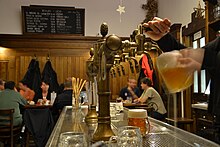
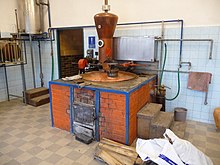
Czech beer is world famous and has a long brewing tradition. The Pilsner brewing style has spread far beyond the Czech Republic. Internationally known brands are for example Pilsner Urquell , Budweiser , Velkopopovický Kozel , Staropramen , Starobrno , Bernard , Svijany or Březňák . The Czechs are world champions in beer drinking. According to statistics from 2014, a Czech drinks 144 liters, a German 107 liters and an Austrian 104 liters of beer a year. Before 1990 there were numerous breweries in the Czech Republic . In the period that followed, the brewery died out, but this trend has now reversed. The number of breweries grew from 66 in 2000 to 163 in 2011, mainly due to a boom in local microbreweries .
Viticulture has been practiced in the Czech Republic for ages. The largest wine-growing region is in South Moravia . Wine is also grown in the area around Litoměřice and Mělník in Central Bohemia . This has shaped the architecture in many places: behind inconspicuous houses there are entrances to large wine cellars.
The fruit brandy has a long tradition in the Czech Republic. Plum brandy ( slivovice ) is obtained from plums, and is a national drink in eastern Moravia. Apple ( jabkovice ), pear ( hruškovice ) and apricot or apricot brandy ( meruňkovice ) are also common. Borovička is a juniper spirit with herbs.
Coffee is often prepared as a turek ("Turk"); To do this, a teaspoon of very finely ground coffee is poured into a glass and boiling water is poured over it. The coffee is sweetened, stirred and drunk after weaning. The coffee grounds are left over.
Internationally known beverage brands:
- Pilsner Urquell ( "Plzeňský Prazdroj" ): Beer brewed in the Pilsner style .
- Budweiser Budvar ( "Budějovický Budvar" ): Budweiser beer.
- Mattoni : mineral water from Karlovy Vary
- Becherovka : Carlsbad herbal liqueur with a bittersweet taste. The original recipe by Josef Becher, Johann Becher’s father, dates back to 1807.
- Stará myslivecká ("old hunter schnapps "): a brandy, is dubbed "Czech cognac".
- Kofola is a cola drink widespread in the Czech Republic, Slovakia and Poland.
literature
- Magdaléna Dobromila Rettigová , Georg J. Morava (editor), Mikoláš Aleš (illustrator): Old Bohemian cuisine . The best of the culinary oeuvre of Magdaléna Dobromila Rettigová. Edition Loewenzahn, Innsbruck 2006, ISBN 978-3-7066-2356-8 (The author is considered a “classic” in her Czech homeland).
- Hana Rigo, This is how you cook in Bohemia . Verlag Wilhelm Ennsthaler, Steyr, ISBN 3-85068-414-8 (reference work)
- Jana Hrušová, Libuše Janačková: From Liwanzen, Kolatschen and Budweiser beer soup. What the Bohemian cook Blažena brought to the table for her reign . CSI, Wiesbaden 1978 / Haedecke, Weil der Stadt 1982, ISBN 3-7750-0108-5 . (The cover erroneously says “Libuša Janačeková”.)
- Juliana Fialová, Květoslava Stybliková: Bohemian cuisine , illustrated by Olga Davidová, S. Němec (photos), Antonín Chmel (graphics), translated by Ludvík Gregor. Artia, Prague / Vehling, Graz 1983.
- Joza Břízová, Maryna Klimentová: Czech cuisine . Práce, Prague / Verlag für die Frau, Leipzig 1982/1984/1985/1989, ISBN 978-3-7304-0018-0 .
- Ilse Froidl: Bohemian specialties. Over 300 recipes of the world famous Bohemian cuisine . Heyne, Munich 1980, ISBN 3-453-40016-X .
- Ilse Froidl: Bohemian cuisine . 18th edition. Ascent, Landshut 2002, ISBN 3-7612-0034-X .
- Michael Korth, Eva Lechner: Schwejks Bohemian cookbook . Eichborn, Frankfurt am Main 2001, ISBN 3-8218-3728-4 .
- Peter Ploog (ed.): Bohemian cuisine . Komet, Cologne 2006, ISBN 978-3-89836-427-0 .
- Harald Salfellner: The best Bohemian recipes . Vitalis, 2011, ISBN 978-3-89919-100-4 .
- Georg R. Schroubek , Petr Lozoviuk: Studies on Bohemian Folklore . Waxmann, Münster 2008, ISBN 978-3-8309-1879-0 .
- Klaus Teuber: Old Bohemian cuisine . Area, Erftstadt 2005, ISBN 978-3-89996-173-7 .
- Gotthard B. Schicker : Cultural history of gastronomy in the Saxon and Bohemian Ore Mountains (scientific project study / Objective 3 project Erzgebirge / Krušnohoří culinary experience ), 135 pages, Ore Mountains Economic Development Agency, Annaberg-Buchholz, December 2013
- Marie Hrubá with collective: Naše kuchařka (“Our Kitchen”). Státní zemědělské nakladatelství Praha (State Agricultural Publishing House Prague), 1957 (several editions with different titles, e.g. Kuchařka naší vesnice ["Kitchen of our village"] from 1970)
Web links
Individual evidence
- ↑ Hana Rigo: This is how you cook in Bohemia ; Ennsthaler Verlag Steyr, 4th edition 1999; ISBN 3-85068-414-8
- ↑ Survey of the Czech Institute of Sociology 2003 ( Memento from March 30, 2012 in the Internet Archive ; PDF) (Czech)
- ↑ Per capita consumption of beer in Europe
- ^ Association of Czech Breweries and Malts ( Memento from December 22, 2015 in the Internet Archive ) (Czech)




